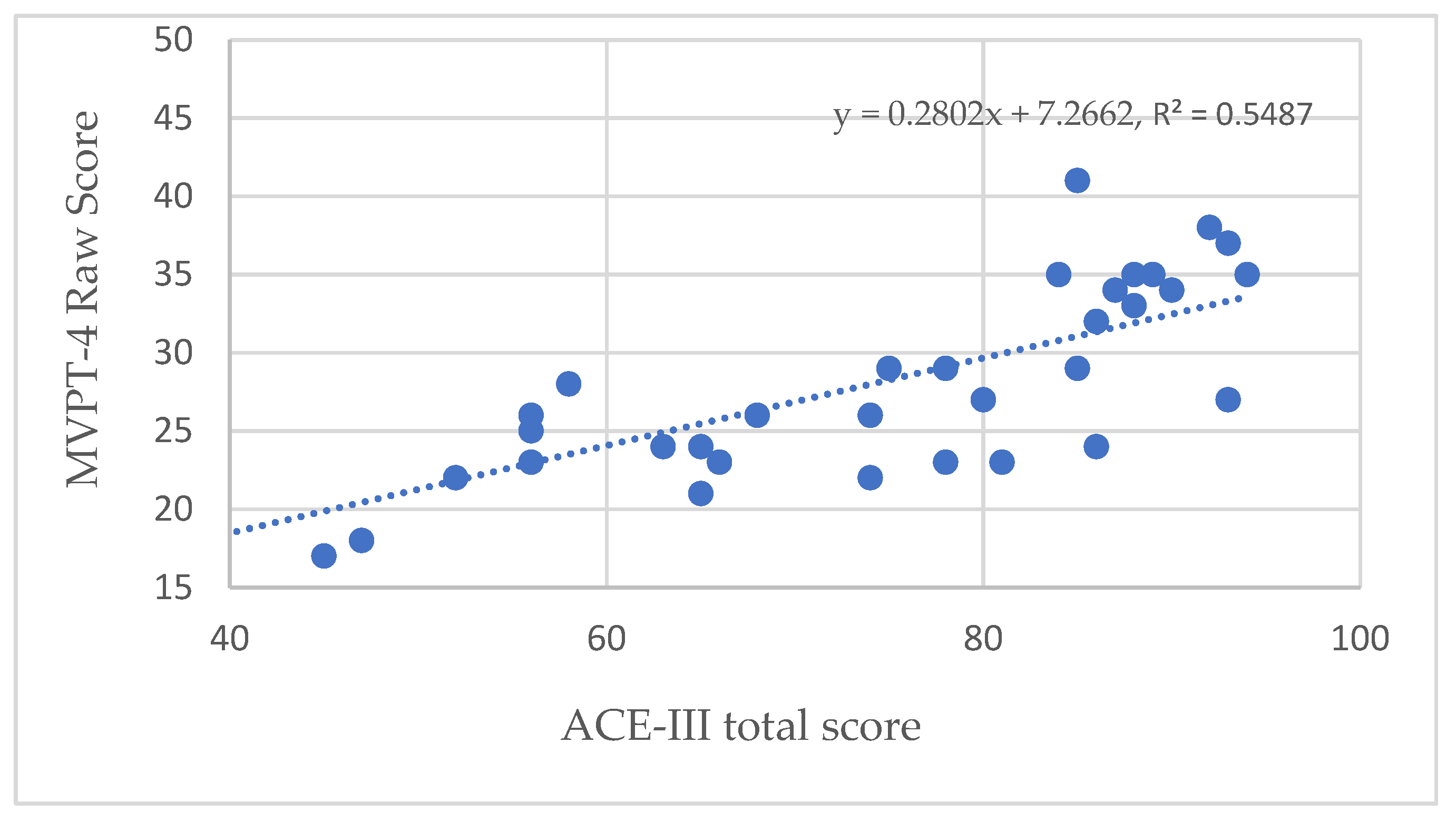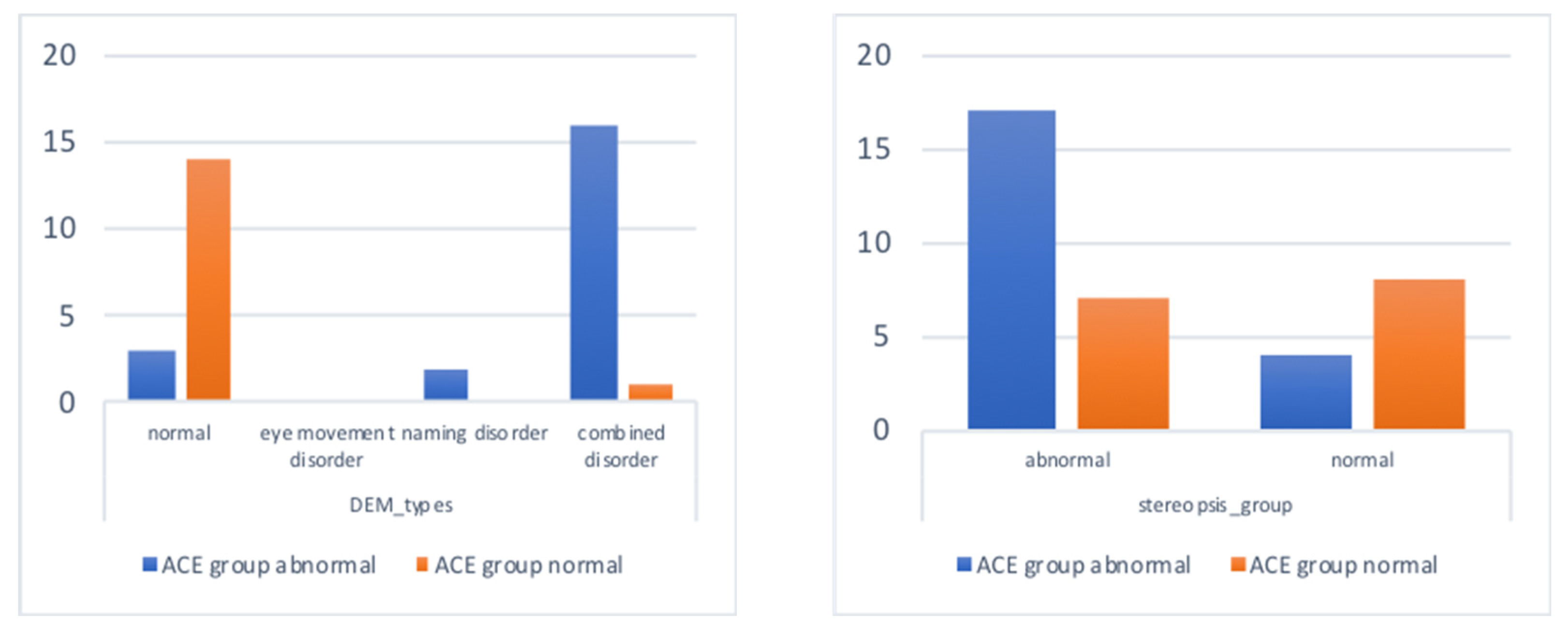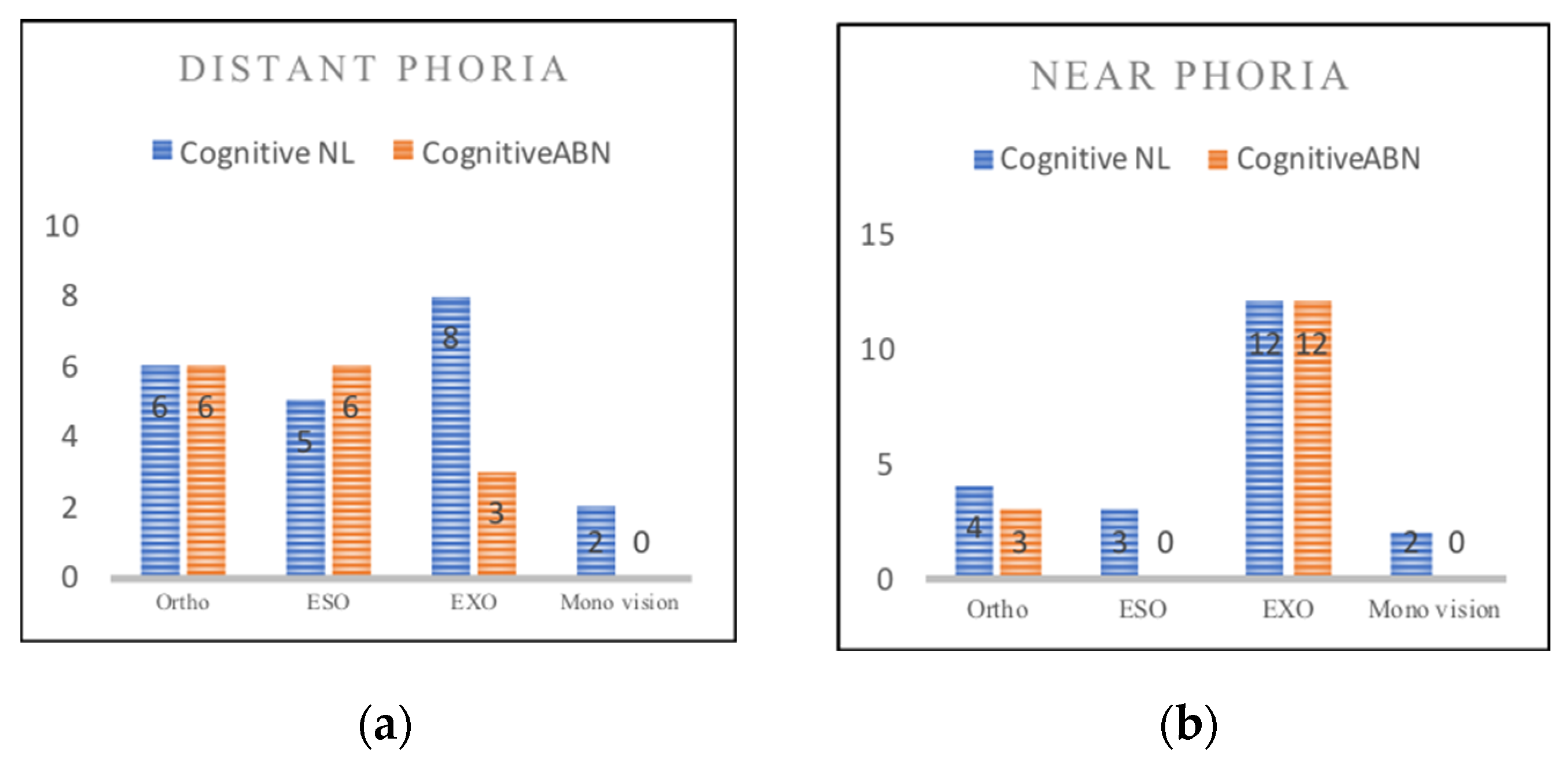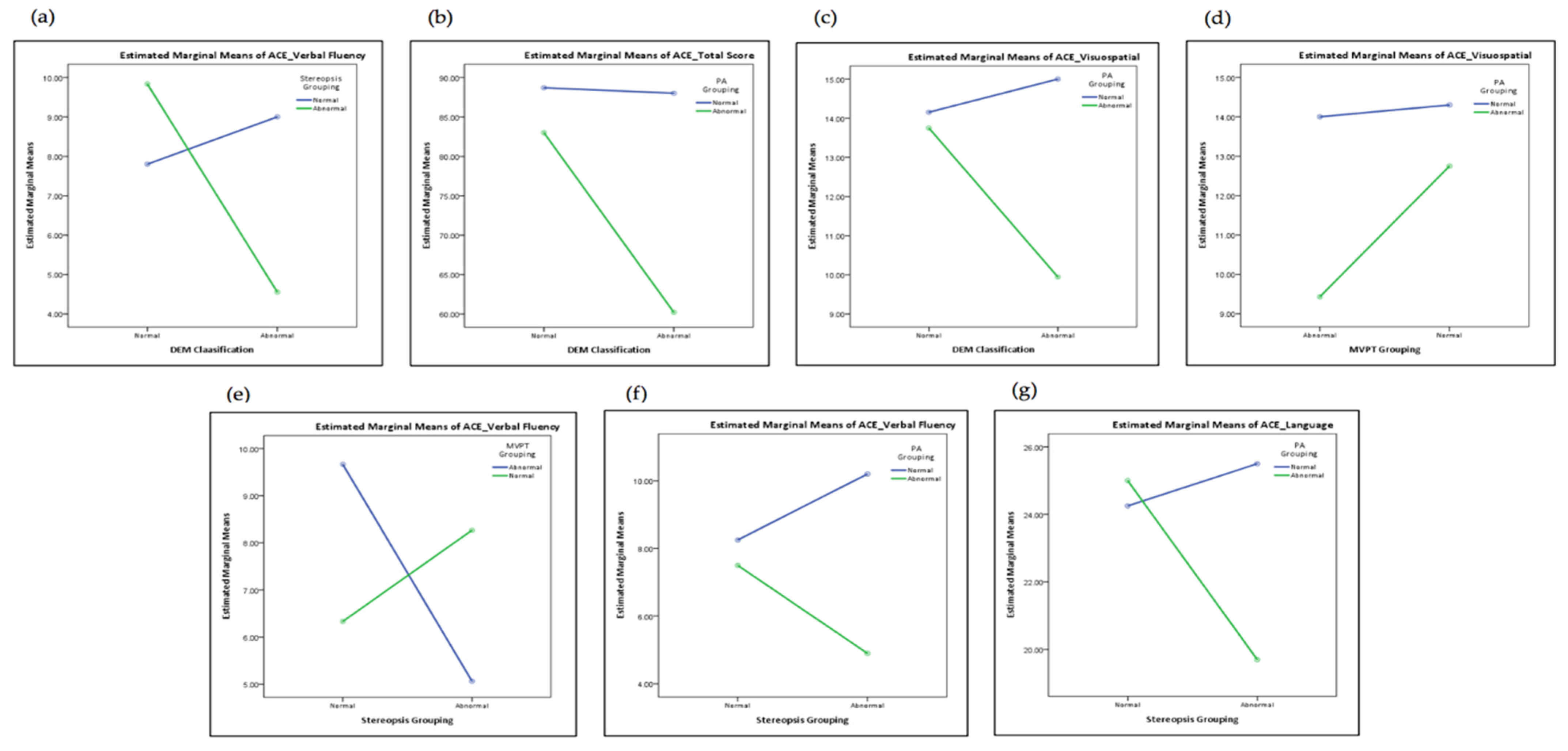Visual Function and Visual Perception among Senior Citizens with Mild Cognitive Impairment in Taiwan
Abstract
1. Introduction
2. Materials and Methods
2.1. Research Subjects
2.2. Research Materials
2.3. Data Analysis and Statistical Analysis
3. Results
3.1. Validating ACE-III
3.2. Correlating Cognitive and Visual Functions
3.3. Specifics of Cognitive and Visual Correlation
3.3.1. Visual Function and Cognitive Function
3.3.2. Visual Perception and Cognitive Function
3.3.3. Interaction between Visual Function, Visual Perception, and Cognitive Function
3.3.3-1. Interaction between Eye Movement (DEM) and Stereopsis on ACE Examina-tion
3.3.3-2. Interaction between DEM and Peripheral Awareness on ACE Examination
3.3.3-3. Interaction between MVPT-4 and Peripheral Awareness on ACE Examination
3.3.3-4. Interaction between Stereopsis and MVPT-4 on ACE Examination
3.3.3-5. Interaction between Stereopsis and Peripheral Awareness on ACE Examination
4. Discussion
5. Conclusions
Author Contributions
Funding
Institutional Review Board Statement
Informed Consent Statement
Data Availability Statement
Conflicts of Interest
References
- Lin, L.-J.; Hsu, Y.-C.; Kuo, H.-W. The prospects and opportunities of age-friendly Taiwan. J. Formos. Med. Assoc. 2018, 118, 655–656. [Google Scholar] [CrossRef]
- Andrade, C.; Radhakrishnan, R. The prevention and treatment of cognitive decline and dementia: An overview of recent research on experimental treatments. Indian J. Psychiatry 2009, 51, 12–25. [Google Scholar] [CrossRef] [PubMed]
- Gillis, C.; Mirzaei, F.; Potashman, M.; Ikram, M.A.; Maserejian, N. The incidence of mild cognitive impairment: A systematic review and data synthesis. Alzheimer’s Dement. Diagn. Assess. Dis. Monit. 2019, 11, 248–256. [Google Scholar] [CrossRef] [PubMed]
- Campbell, N.L.; Unverzagt, F.; LaMantia, M.A.; Khan, B.A.; Boustani, M.A. Risk Factors for the Progression of Mild Cognitive Impairment to Dementia. Clin. Geriatr. Med. 2013, 29, 873–893. [Google Scholar] [CrossRef]
- Farias, S.T.; Mungas, D.; Reed, B.R.; Harvey, D.; DeCarli, C. Progression of Mild Cognitive Impairment to Dementia in Clinic- vs. Community-Based Cohorts. Arch. Neurol. 2009, 66, 1151–1157. [Google Scholar] [CrossRef]
- Petersen, R.C. Mild Cognitive Impairment. Contin. Lifelong Learn. Neurol. 2016, 22, 404–418. [Google Scholar] [CrossRef] [PubMed]
- Borson, S.; Frank, L.; Bayley, P.J.; Boustani, M.; Dean, M.; Lin, P.; McCarten, J.R.; Morris, J.C.; Salmon, D.P.; Schmitt, F.A.; et al. Improving dementia care: The role of screening and detection of cognitive impairment. Alzheimer’s Dement. 2013, 9, 151–159. [Google Scholar] [CrossRef]
- Bruno, D.; Vignaga, S.S. Addenbrooke’s cognitive examination III in the diagnosis of dementia: A critical review. Neuropsychiatr. Dis. Treat. 2019, 15, 441–447. [Google Scholar] [CrossRef]
- Matias-Guiu, J.A.; Cabrera-Martín, M.N.; Pérez-Pérez, A.; Valles-Salgado, M.; Rognoni, T.; Cortés-Martínez, A.; Moreno-Ramos, T.; Carreras, J.L.; Matias-Guiu, J. Neural basis of the Addenbrooke’s Cognitive Examination III: An 18F-fluorodeoxyglucose positron emission tomography study.(P6. 306). Neurology 2017, 88. Available online: https://n.neurology.org/content/88/16_Supplement/P6.306 (accessed on 10 November 2021).
- Kaido, M.; Fukui, M.; Kawashima, M.; Negishi, K.; Tsubota, K. Relationship between visual function and cognitive function in the elderly: A cross-sectional observational study. PLoS ONE 2020, 15, e0233381. [Google Scholar] [CrossRef]
- Wittich, W.; Al-Yawer, F.; Phillips, N. Visual acuity and contrast sensitivity at various stages of cognitive impairment in the COMPASS-ND study. Investig. Ophthalmol. Vis. Sci. 2019, 60, 5913. [Google Scholar]
- Mandal, P.K.; Joshi, J.; Saharan, S. Visuospatial perception: An emerging biomarker for Alzheimer’s disease. J. Alzheimers Dis. 2012, 31, S117–S135. [Google Scholar] [CrossRef]
- Kim, N.; Lee, H. Stereoscopic Depth Perception and Visuospatial Dysfunction in Alzheimer’s Disease. Healthcare 2021, 9, 157. [Google Scholar] [CrossRef] [PubMed]
- Deschamps, T.; Beauchet, O.; Annweiler, C.; Cornu, C.; Mignardot, J.-B. Postural control and cognitive decline in older adults: Position versus velocity implicit motor strategy. Gait Posture 2014, 39, 628–630. [Google Scholar] [CrossRef] [PubMed]
- Liu-Ambrose, T.Y.; Ashe, M.C.; Graf, P.; Beattie, B.L.; Khan, K.M. Increased Risk of Falling in Older Community-Dwelling Women With Mild Cognitive Impairment. Phys. Ther. 2008, 88, 1482–1491. [Google Scholar] [CrossRef]
- Park, D.-J. Effect of visual stimulus using central and peripheral visual field on postural control of normal subjects. J. Phys. Ther. Sci. 2016, 28, 1769–1771. [Google Scholar] [CrossRef] [PubMed][Green Version]
- Dourthe, L.; Sagot, C.; Mélissa, P.; Dieudonné, B.; Greffard, S.; Barrou, Z.; Verny, M. Disorders of Visual Peception for the Elderly with Beginning Cognitive Impairments: Reevaluation. Innov. Aging 2017, 1, 866. [Google Scholar] [CrossRef][Green Version]
- Bowen, M.; Edgar, D.F.; Hancock, B.; Haque, S.; Shah, R.; Buchanan, S.; Iliffe, S.; Maskell, S.; Pickett, J.; Taylor, J.-P. The Prevalence of Visual Impairment in People with Dementia (the PrOVIDe study): A cross-sectional study of people aged 60–89 years with dementia and qualitative exploration of individual, carer and professional perspectives. Health Serv. Deliv. Res. 2016, 4. [Google Scholar] [CrossRef]
- Liu, X.; Chen, M.H.; Yue, G.H. Postural Control Dysfunction and Balance Rehabilitation in Older Adults with Mild Cognitive Impairment. Brain Sci. 2020, 10, 873. [Google Scholar] [CrossRef]
- Nie, J.; Qiu, Q.; Phillips, M.; Sun, L.; Yan, F.; Lin, X.; Xiao, S.; Li, X. Early Diagnosis of Mild Cognitive Impairment Based on Eye Movement Parameters in an Aging Chinese Population. Front. Aging Neurosci. 2020, 12, 221. [Google Scholar] [CrossRef]
- Facchin, A.; Maffioletti, S.; Carnevali, T. The Developmental Eye Movement (DEM) Test: Normative Data for Italian Population. Optom. Vis. Dev. 2012, 43, 162–179. [Google Scholar]
- Armstrong, R.A. Alzheimer’s disease and the eye. J. Optom. 2009, 2, 103–111. [Google Scholar] [CrossRef]
- Rogers, M.A.M.; Langa, K. Untreated Poor Vision: A Contributing Factor to Late-Life Dementia. Am. J. Epidemiol. 2010, 171, 728–735. [Google Scholar] [CrossRef]
- Montés-Micó, R. Prevalence of general dysfunctions in binocular vision. Ann. Ophthalmol. 2001, 33, 205–208. [Google Scholar] [CrossRef]
- Sunjic-Alic, A.; Zebenholzer, K.; Gall, W. Reporting of Studies Conducted on Austrian Claims Data. Stud. Health Technol. Inform. 2021, 279, 62–69. Available online: https://pubmed.ncbi.nlm.nih.gov/33965920/ (accessed on 20 December 2021). [CrossRef] [PubMed]
- Cuschieri, S. The STROBE guidelines. Saudi J. Anaesth. 2019, 13 (Suppl. 1), S31–S34. [Google Scholar] [CrossRef] [PubMed]
- Kapadia, M.K.; Westheimer, G.; Gilbert, C.D. Spatial Distribution of Contextual Interactions in Primary Visual Cortex and in Visual Perception. J. Neurophysiol. 2000, 84, 2048–2062. [Google Scholar] [CrossRef] [PubMed]
- Aedo-Jury, F.; Pins, D. Time compression increases with eccentricity: A magnocellular property. NeuroReport 2010, 21, 84–89. [Google Scholar] [CrossRef] [PubMed]
- Kim, S.-H.; Park, J.-H.; Kim, Y.H.; Koh, S.-B. Stereopsis in Drug Naïve Parkinson’s Disease Patients. Can. J. Neurol. Sci. 2011, 38, 299–302. [Google Scholar] [CrossRef][Green Version]
- Ardila, A.; Bernal, B.; Rosselli, M. Language and Visual Perception Associations: Meta-Analytic Connectivity Modeling of Brodmann Area 37. Behav. Neurol. 2015, 2015, 565871. [Google Scholar] [CrossRef] [PubMed]
- Song, H.C.; Kim, J.; Kim, S.-W.; Lee, B.-I.; Shin, I.-S.; Kim, J.-M.; Yoon, J.S.; Park, T. Correlation of changes of regional cerebral blood flow with cognitive decline in patients with schizophrenia. J. Nucl. Med. 2007, 48, 260. [Google Scholar]
- Vallar, G.; Bottini, G.; Paulesu, E. Neglect syndromes: The role of the parietal cortex. Adv. Neurol. 2003, 93, 293–319. [Google Scholar]
- Mapstone, M.; Steffenella, T.M.; Duffy, C.J. A visuospatial variant of mild cognitive impairment: Getting lost between aging and AD. Neurology 2003, 60, 802–808. [Google Scholar] [CrossRef] [PubMed]
- Stasheff, S.; Barton, J. Deficits in cortical visual function. Ophthalmol. Clin. North Am. 2001, 14, 217–242. [Google Scholar] [PubMed]
- Rodriguez-Porcel, F.; Wilmskoetter, J.; Cooper, C.; Taylor, J.A.; Fridriksson, J.; Hickok, G.; Bonilha, L. The relationship between dorsal stream connections to the caudate and verbal fluency in Parkinson disease. Brain Imaging Behav. 2020, 15, 2121–2125. [Google Scholar] [CrossRef] [PubMed]
- Orloff, S. Learning Re-Enabled: A Practical Guide to Helping Children with Learning Disabilities; Mosby: St. Louis, MO, USA, 2004. [Google Scholar]




| ACE-Abnormal N = 21 M (SD) | ACE-Normal N = 15 M (SD) | Levene F Value | t | p | d | |
|---|---|---|---|---|---|---|
| DEM VT | 60.86(23.42) | 30.20(6.50) | 27.51 | 5.70 | 0.000 | 1.66 |
| DEM HT | 84.38(37.41) | 31.87(8.03) | 33.44 | 6.24 | 0.000 | 1.80 |
| DEM Ratio | 1.35(0.20) | 1.06(0.12) | 5.07 | 5.63 | 0.000 | 1.69 |
| Stereopsis | 2.40(0.55) | 1.93(0.41) | 4.23 | 2.95 | 0.006 | 0.95 |
| Contrast Sensitivity | 1.37(0.38) | 1.25(0.00) | 7.45 | 1.45 | 0.162 | 0.41 |
| ACE Total Score | ACE Attention | ACE Memory | ACE Fluency | ACE Language | ACE Visuospatial | ||
|---|---|---|---|---|---|---|---|
| DEM VT | β | - | −0.78 | −0.32 | - | −0.66 | - |
| p | - | 0.000 | 0.009 | - | 0.000 | - | |
| DEM HT | β | −0.71 | - | - | −0.54 | - | −0.65 |
| p | 0.000 | - | - | 0.000 | - | 0.000 | |
| DEM Ratio | β | - | - | −0.62 | - | - | - |
| p | - | - | 0.000 | - | - | - | |
| Stereopsis | β | −0.30 | - | - | −0.35 | −0.27 | −0.44 |
| p | 0.000 | - | - | 0.008 | 0.024 | 0.000 | |
| Adjusted R2 | 0.761 | 0.597 | 0.729 | 0.555 | 0.615 | 0.556 | |
| F | 56.84 | 52.76 | 48.16 | 22.84 | 28.93 | 50.55 | |
| VIF | 1.21 | 1 | 1.74 | 1.21 | 1.16 | 1.09 | |
| ACE Total Score | Attention | Memory | Language Fluency | Language | Visuospatial | |
|---|---|---|---|---|---|---|
| χ2 | 23.37 | 10.99 | 25.42 | 17.45 | 18.21 | 18.52 |
| p | 0.000 | 0.000 | 0.000 | 0.000 | 0.000 | 0.000 |
| Post-Hoc | A > D | A > D | A > D A > C | A > D | A > D | A > D |
| ACE-Abnormal N = 21 M (SD) | ACE-Normal N = 15 M (SD) | Levene F Value | t | p | d | |
|---|---|---|---|---|---|---|
| MVPT | 23.90(3.51) | 33.60(5.57) | 0.13 | −7.47 | 0.000 | 2.17 |
| Visual Discrimination | 5.57(1.29) | 7.67(1.18) | 0.09 | −4.99 | 0.000 | 1.69 |
| Figure-Ground | 4.57(1.40) | 6.20(1.08) | 1.33 | −3.77 | 0.001 | 1.28 |
| Visual Memory | 4.95(1.36) | 6.80(1.82) | 2.08 | −3.49 | 0.001 | 1.18 |
| Spatial relationship | 4.38(1.02) | 6.07(1.67) | 1.79 | −3.76 | 0.001 | 1.27 |
| Visual Closure | 4.43(1.69) | 6.87(1.68) | 0.01 | −4.27 | 0.000 | 1.45 |
| Peripheral Awareness | 13.00(4.53) | 21.87(3.96) | 0.15 | −6.09 | 0.000 | 2.06 |
| ACE Total Score | ACE Attention | ACE Memory | ACE Fluency | ACE Language | ACE Visuospatial | ||
|---|---|---|---|---|---|---|---|
| MVPT-4 total score | β | - | 0.64 | 0.34 | - | - | 0.70 |
| p | - | 0.000 | 0.014 | - | - | 0.000 | |
| MVPT-4 Visual Memory | β | 0.38 | - | - | - | 0.36 | - |
| p | 0.000 | - | - | - | 0.003 | - | |
| Peripheral awareness | β | 0.68 | - | 0.60 | 0.63 | 0.61 | - |
| p | 0.000 | - | 0.000 | 0.000 | 0.000 | - | |
| Adjusted R2 | 0.719 | 0.393 | 0.651 | 0.380 | 0.580 | 0.473 | |
| F | 45.69 | 23.41 | 33.68 | 22.44 | 25.18 | 32.44 | |
| VIF | 1.07 | 1 | 1.71 | 1 | 1.07 | 1 | |
Publisher’s Note: MDPI stays neutral with regard to jurisdictional claims in published maps and institutional affiliations. |
© 2021 by the authors. Licensee MDPI, Basel, Switzerland. This article is an open access article distributed under the terms and conditions of the Creative Commons Attribution (CC BY) license (https://creativecommons.org/licenses/by/4.0/).
Share and Cite
Chang, C.-W.; Su, K.-C.; Lu, F.-C.; Cheng, H.-M.; Cheng, C.-Y. Visual Function and Visual Perception among Senior Citizens with Mild Cognitive Impairment in Taiwan. Healthcare 2022, 10, 20. https://doi.org/10.3390/healthcare10010020
Chang C-W, Su K-C, Lu F-C, Cheng H-M, Cheng C-Y. Visual Function and Visual Perception among Senior Citizens with Mild Cognitive Impairment in Taiwan. Healthcare. 2022; 10(1):20. https://doi.org/10.3390/healthcare10010020
Chicago/Turabian StyleChang, Chi-Wu, Kuo-Chen Su, Fang-Chun Lu, Hong-Ming Cheng, and Ching-Ying Cheng. 2022. "Visual Function and Visual Perception among Senior Citizens with Mild Cognitive Impairment in Taiwan" Healthcare 10, no. 1: 20. https://doi.org/10.3390/healthcare10010020
APA StyleChang, C.-W., Su, K.-C., Lu, F.-C., Cheng, H.-M., & Cheng, C.-Y. (2022). Visual Function and Visual Perception among Senior Citizens with Mild Cognitive Impairment in Taiwan. Healthcare, 10(1), 20. https://doi.org/10.3390/healthcare10010020






